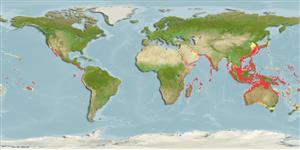>
Scombriformes (Mackerels) >
Scombridae (Mackerels, tunas, bonitos) > Scombrinae
Etymology: Sarda: Latin and Greek, sarda = sardine; name related to the island of Sardinia (Ref. 45335).
More on authors: Temminck & Schlegel.
Environment: milieu / climate zone / depth range / distribution range
นิเวศวิทยา
เกี่ยวกับทะเล,น้ำเค็ม; สัตว์น้ำที่อาศัยและอพยพภายในทะเลเท่านั้น (Ref. 51243); ระดับความลึก 1 - 167 m (Ref. 58302). Subtropical; 14°C - 23°C (Ref. 168); 43°N - 41°S, 24°E - 77°W (Ref. 168)
Indo-Pacific: widespread but with many gaps in its known distribution. Eastern Pacific: Hawaiian Islands and Pacific coast of USA to southern tip of Baja California and Tres Marias Islands extending to Cabo Blanco, Peru (especially during El Niño events), the Galapagos Islands and Gulf of Guayaquil.
Length at first maturity / ขนาด / น้ำหนัก / Age
Maturity: Lm 47.8, range 45 - ? cm
Max length : 102 cm FL เพศผู้/กระเทย; (Ref. 9684); common length : 55.0 cm TL เพศผู้/กระเทย; (Ref. 55763); น้ำหนักสูงสุดที่มีการรายงาน: 10.7 kg (Ref. 168)
เงี่ยงครีบหลัง (รวม): 17 - 19; เงี่ยงครีบก้น 0; ก้านครีบอ่อนที่ก้น: 14 - 16; สัตว์มีกระดูกสันหลัง: 44 - 45. Mouth moderately large. Laminae of olfactory rosette 21 to 39. Interpelvic process small and bifid. Body completely covered with very small scales posterior to the corselet. Swim bladder absent. Spleen large and prominent in ventral view. Liver with elongate left and right lobes and a short middle lobe. Back with narrow oblique stripes.
A coastal species (Ref. 9340) found schooling with small tunas. Also found around some islands (Ref. 9684). Feeds on clupeoids, other fishes, squids and decapod crustaceans. Spawning varies with the monsoon season (Ref. 9684). Also caught with troll lines, encircling nets (Ref. 9340) and drift nets (Ref. 9684). Marketed mainly fresh; also dried-salted (Ref. 9684), canned and frozen (Ref. 9987).
Collette, B.B. and C.E. Nauen, 1983. FAO Species Catalogue. Vol. 2. Scombrids of the world. An annotated and illustrated catalogue of tunas, mackerels, bonitos and related species known to date. Rome: FAO. FAO Fish. Synop. 125(2):137 p. (Ref. 168)
IUCN Red List Status (Ref. 130435)
Threat to humans
Harmless
Human uses
การประมง: มีการค้าเพียงเล็กน้อย; การตกปลาเป็นกีฬา: ใช่
ข้อมูลเพิ่มเติม
ผู้ร่วมมือรูปภาพหลายรูปStamps, Coins Misc.เสียงปลามีพิษ เช่น ปลาปักเป้าความเร็วรูปแบบการว่ายน้ำพื้นที่เหงือกOtolithsสมองวิสัยทัศน์
เครื่องมือ
Special reports
Download XML
แหล่งที่มาจากอินเตอร์เน็ต
Estimates based on models
Preferred temperature (Ref.
123201): 20.5 - 29, mean 27.6 °C (based on 2552 cells).
Phylogenetic diversity index (Ref.
82804): PD
50 = 0.5312 [Uniqueness, from 0.5 = low to 2.0 = high].
Bayesian length-weight: a=0.01000 (0.00520 - 0.01924), b=3.05 (2.89 - 3.21), in cm total length, based on LWR estimates for this species & (Sub)family-body (Ref.
93245).
ระดับชั้นอาหาร (Ref.
69278): 4.2 ±0.69 se; based on food items.
Generation time: 1.6 ( na - na) years. Estimated as median ln(3)/K based on 2
growth studies.
ความสามารถในการกลับคืนสู่ปกติ (Ref.
120179): ขนาดกลาง, เวลาต่ำสุดที่จะทำให้ประชากรเพิ่มขึ้นเป็น 2 เท่าใช้เวลา 1.4 - 4.4 ปี (Assuming tm=3-4).
Fishing Vulnerability (Ref.
59153): Moderate vulnerability (35 of 100).
Climate Vulnerability (Ref.
125649): High vulnerability (59 of 100).
Nutrients (Ref.
124155): Calcium = 37.8 [21.1, 63.0] mg/100g; Iron = 2.61 [1.51, 4.59] mg/100g; Protein = 20.7 [19.5, 21.8] %; Omega3 = 0.356 [0.167, 0.745] g/100g; Selenium = 32.3 [18.0, 56.1] μg/100g; VitaminA = 13.9 [5.5, 37.6] μg/100g; Zinc = 0.462 [0.350, 0.686] mg/100g (wet weight);
